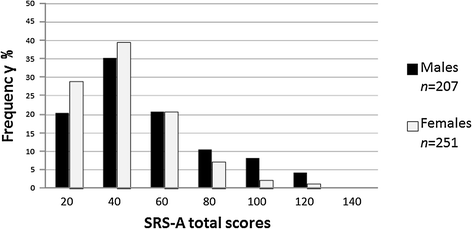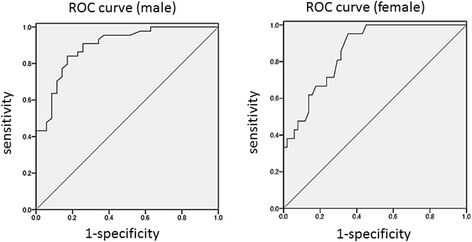Verification of the utility of the social responsiveness scale for adults in non-clinical and clinical adult populations in Japan
- PMID: 25403232
- PMCID: PMC4237729
- DOI: 10.1186/s12888-014-0302-z
Verification of the utility of the social responsiveness scale for adults in non-clinical and clinical adult populations in Japan
Abstract
Background: Recently great attention has been paid to the still unmet clinical needs of most adults with autism spectrum disorder (ASD) who live in the community, an increasing number of whom visit psychiatric clinics to seek accurate diagnosis and treatment of concurrent psychiatric symptoms. However, different from the case of children diagnosed with ASD in childhood, it is difficult in adults to identify the ASD symptoms underlying psychopathology and to differentiate ASD from other psychiatric disorders in general psychiatric practice. This study aimed to verify the utility of the Social Responsiveness Scale-Adult version (SRS-A), a quantitative measure for identifying ASD symptoms, in non-clinical and clinical adult populations in Japan.
Methods: The total sample aged 19 to 59 years consisted of a non-clinical population (n =592) and clinical population with and without ASD (n =142). We examined score distributions of the Japanese version of the scale, and the effects of gender, age, and rater on the distribution. We analyzed factor structure and internal consistency in the non-clinical normative sample, and analyzed convergent, divergent, and discriminative validities in the clinical sample. We applied receiver operator characteristic (ROC) analysis to determine optimal cutoff scores discriminating the ASD clinical population from the non-ASD clinical population.
Results: The score distributed continuously, which replicated findings in children. For non-clinical adults, except in men aged 19 to 24 years, we found no or few gender, age, or rater effects. Both single- and two-factor models were supported for adults. Total SRS-A scores demonstrated high internal consistency and capably discriminated adults with ASD from those with non-ASD psychiatric disorders such as major depressive disorder, schizophrenia, and bipolar disorder with an overlap across diagnoses. Moderate to high correlations of the SRS-A with other-rated ASD measures indicated sufficient convergent validity. Based on the ROC analysis, we recommend cutoff points by gender for use in clinical settings.
Conclusion: This study provides additional supportive evidence that the Japanese version SRS-A can reliably and validly measure ASD symptoms in non-clinical and clinical adult populations, and thus can serve as a useful tool for ASD research as well as for secondary screening in Japanese adults.
Figures
Similar articles
-
Assessment of Autistic Traits in Children Aged 2 to 4½ Years With the Preschool Version of the Social Responsiveness Scale (SRS-P): Findings from Japan.Autism Res. 2017 May;10(5):852-865. doi: 10.1002/aur.1742. Epub 2017 Mar 3. Autism Res. 2017. PMID: 28256099 Free PMC article.
-
The social responsiveness scale in relation to DSM IV and DSM5 ASD in Korean children.Autism Res. 2016 Sep;9(9):970-80. doi: 10.1002/aur.1671. Epub 2016 Sep 8. Autism Res. 2016. PMID: 27604989 Free PMC article.
-
Validity of the social responsiveness scale to differentiate between autism spectrum disorders and disruptive behaviour disorders.Eur Child Adolesc Psychiatry. 2014 Feb;23(2):81-93. doi: 10.1007/s00787-013-0427-5. Epub 2013 May 30. Eur Child Adolesc Psychiatry. 2014. PMID: 23719758
-
[Psychiatric issues of children and adults with autism spectrum disorders who remain undiagnosed].Seishin Shinkeigaku Zasshi. 2013;115(6):601-6. Seishin Shinkeigaku Zasshi. 2013. PMID: 23944117 Review. Japanese.
-
Screening accuracy of Level 2 autism spectrum disorder rating scales. A review of selected instruments.Autism. 2010 Jul;14(4):263-84. doi: 10.1177/1362361309348071. Autism. 2010. PMID: 20591956 Review.
Cited by
-
The psychometric properties of the Quantitative-Checklist for Autism in Toddlers (Q-CHAT) as a measure of autistic traits in a community sample of Singaporean infants and toddlers.Mol Autism. 2015 Jun 21;6:40. doi: 10.1186/s13229-015-0032-1. eCollection 2015. Mol Autism. 2015. PMID: 26124950 Free PMC article.
-
Genetic architecture of reciprocal social behavior in toddlers: Implications for heterogeneity in the early origins of autism spectrum disorder.Dev Psychopathol. 2020 Oct;32(4):1190-1205. doi: 10.1017/S0954579420000723. Dev Psychopathol. 2020. PMID: 33161906 Free PMC article.
-
Proneness to Self-Conscious Emotions in Adults With and Without Autism Traits.J Autism Dev Disord. 2017 Nov;47(11):3392-3404. doi: 10.1007/s10803-017-3260-8. J Autism Dev Disord. 2017. PMID: 28755034
-
The social responsiveness scale is an efficient screening tool for autism spectrum disorder traits in adults with anorexia nervosa.Eur Eat Disord Rev. 2020 Jul;28(4):433-444. doi: 10.1002/erv.2736. Epub 2020 Apr 3. Eur Eat Disord Rev. 2020. PMID: 32243021 Free PMC article.
-
Autistic-like traits in adult patients with mood disorders and schizophrenia.PLoS One. 2015 Apr 2;10(4):e0122711. doi: 10.1371/journal.pone.0122711. eCollection 2015. PLoS One. 2015. PMID: 25838109 Free PMC article.
References
-
- Kamio Y, Inokuchi E. Hattasushogaisya to Seishinkairyo no Yakuwari: Saikin no Keiko to Kongo no Kadai [Psychiatric practice’s role for individual with developmental disorders: current trend and future issues] J Jpn Assoc Psychiatr Hosp. 2009;28:14–20.
Publication types
MeSH terms
LinkOut - more resources
Full Text Sources
Other Literature Sources



